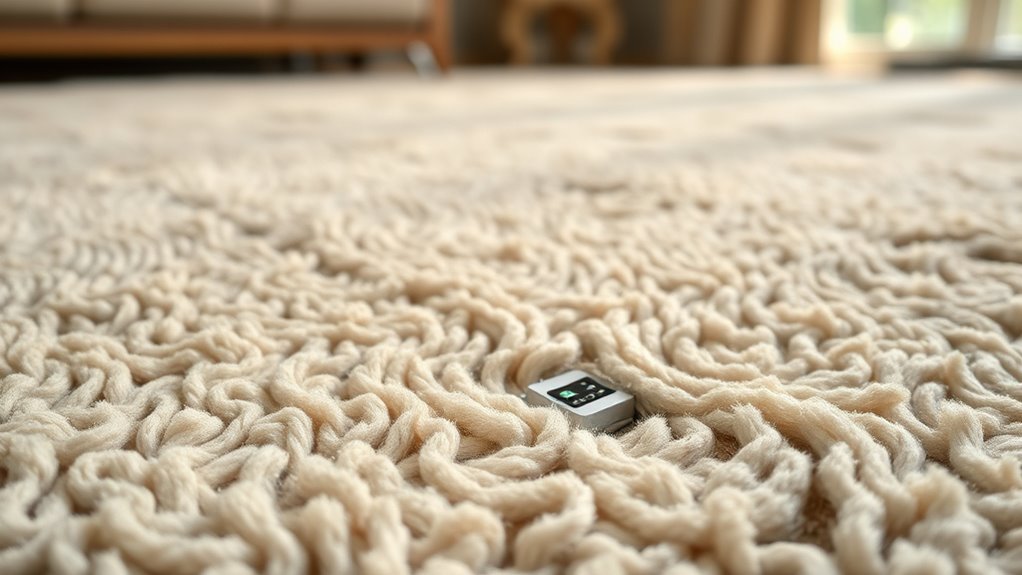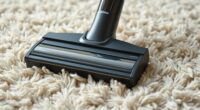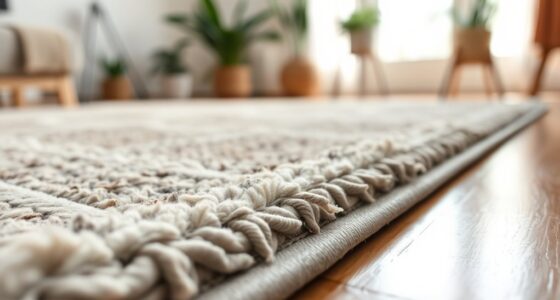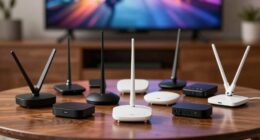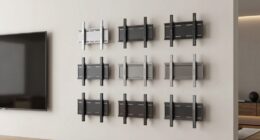Smart sensors can help you monitor humidity under rugs to prevent mold, water damage, and flooring deterioration. By detecting moisture early, they enable you to take quick action, like ventilating or using dehumidifiers. Sensitive to humidity changes, these wireless devices are easy to install in key spots, especially at rug edges or corners. Keep up with best practices and future innovations to stay ahead; there’s more to discover about keeping your home safe and dry.
Key Takeaways
- Smart sensors detect humidity levels under rugs by measuring moisture changes through capacitive or resistive methods.
- Proper placement at rug edges or corners ensures accurate detection of hidden moisture buildup.
- Wireless sensors provide real-time updates remotely, enabling prompt responses to elevated humidity.
- Regular calibration and maintenance sustain sensor accuracy and reliable moisture monitoring.
- Early detection of humidity helps prevent mold growth, flooring damage, and maintains a healthier indoor environment.
Understanding the Importance of Monitoring Humidity Under Rugs

Because humidity levels beneath rugs can go unnoticed, they often cause hidden problems that affect your home’s comfort and integrity. The rug material plays a crucial role in how moisture accumulates and impacts the area. For example, natural fibers like wool absorb moisture more easily, raising humidity thresholds that can lead to mold or mildew if unchecked. Synthetic rugs may resist moisture but still trap humidity underneath. Monitoring these humidity levels is essential to prevent damage, odors, and deterioration of floor structures. Without proper awareness, you might overlook subtle signs of excess moisture, which can compromise your home’s health and safety. Using smart sensors allows you to track humidity beneath rugs accurately, ensuring you stay within safe thresholds and maintain a healthier living environment. Additionally, understanding the role of color accuracy in home conditions can help you better interpret environmental changes that affect indoor air quality. Proper humidity management also supports overall well-being by reducing allergic reactions and respiratory issues. Implementing humidity sensors can provide real-time data, enabling proactive measures to maintain optimal conditions and extend the life of your flooring and furnishings. Regularly checking these readings helps prevent long-term moisture damage that could otherwise lead to costly repairs.
Types of Smart Sensors Suitable for Moisture Detection
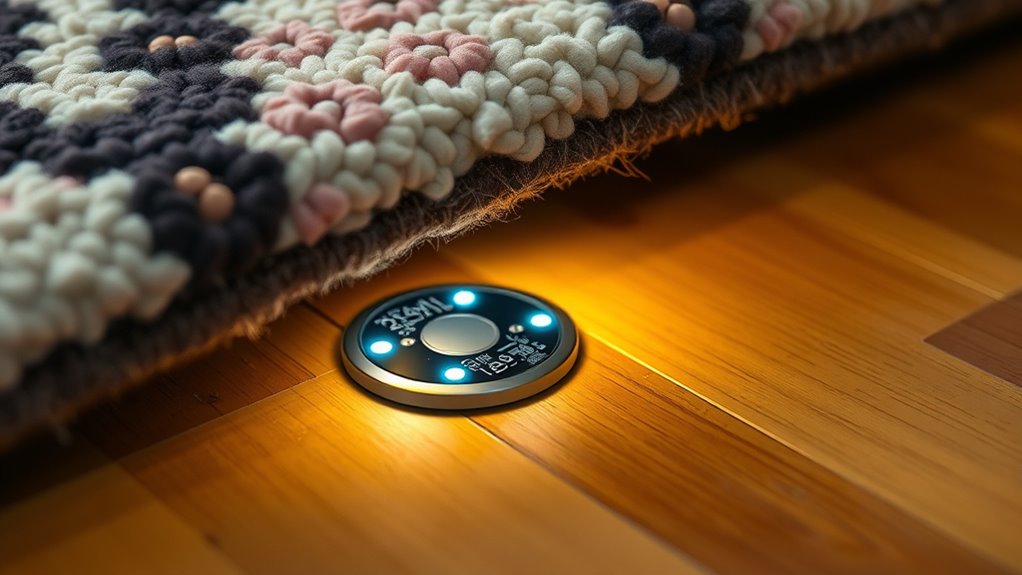
Selecting the right smart sensors for moisture detection beneath rugs involves understanding the various types available and how they work. Capacitive sensors are popular due to their reliability and sensitivity to humidity changes. They often require sensor calibration to maintain accuracy over time. Resistive sensors detect moisture through electrical resistance changes and are simple to install. For seamless integration, choose sensors with wireless connectivity, allowing you to monitor moisture levels remotely without cumbersome wiring. Some sensors combine both sensing methods for enhanced precision. Regardless of type, ensure the sensor supports calibration features to keep readings accurate. Additionally, sensor calibration is essential for maintaining long-term accuracy and reliability. Incorporating AI-powered monitoring into your system can further enhance detection capabilities by analyzing patterns and predicting potential issues before they become severe. Using sensors with environmental adaptability helps ensure consistent performance across different conditions. Selecting sensors with wireless connectivity and proper calibration options can streamline setup and maintenance, making your moisture detection system more effective and user-friendly.
How Smart Sensors Detect Changes in Humidity Levels
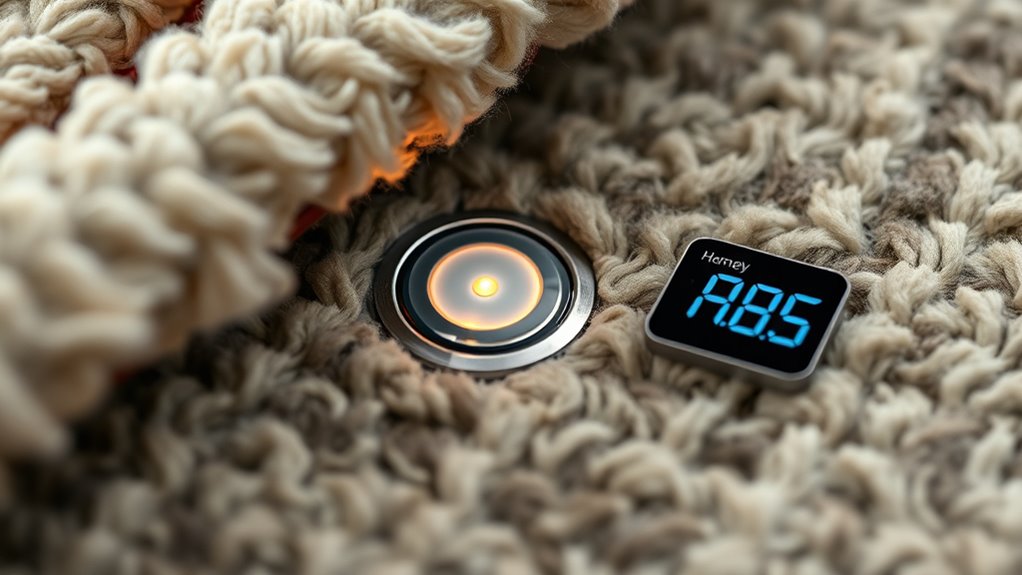
Smart sensors detect changes in humidity levels by measuring variations in electrical properties or physical characteristics within their sensing elements. When humidity increases, sensors experience changes in conductivity or capacitance, which they interpret as moisture level shifts. To guarantee accurate readings, you need to perform sensor calibration regularly, aligning the device’s output with known humidity standards. This process helps eliminate errors caused by sensor drift over time. Additionally, as these sensors transmit data, data encryption is essential to protect your information from unauthorized access. Encryption techniques safeguard data privacy and ensure that only authorized users can access the humidity data. Implementing proper calibration procedures is vital for maintaining sensor accuracy, ensuring reliable, real-time insights into humidity levels under rugs or other surfaces. Regular maintenance and understanding industry transformations can further optimize sensor performance and data security.
Benefits of Using Smart Sensors for Home Moisture Management

Using smart sensors for home moisture management gives you instant updates on humidity levels, so you can act quickly. This real-time detection helps prevent mold growth before it becomes a problem. Proper maintenance and timely filter replacements prevent costly repairs and ensure the sensors function accurately. Regular calibration and cleaning of sensors are essential for maintaining their accuracy and reliability. Ultimately, it keeps your home safer and more comfortable with less effort on your part. Additionally, understanding the importance of humidity control can help you make informed decisions about maintaining a healthy indoor environment. Proper planning around beneficiary designation ensures that your investments are protected and your loved ones are provided for according to your wishes.
Real-Time Moisture Detection
Real-time moisture detection offers immediate insights into humidity levels, allowing you to address issues before they escalate. With smart sensors, you get instant alerts if moisture rises unexpectedly, helping prevent damage early. Proper sensor calibration guarantees accuracy, so you trust the data you receive. Regular maintenance ensures your sensors remain reliable and high pressure performance is sustained over time. You’ll stay in control, avoiding costly repairs and safeguarding your home effortlessly, especially when considering humidity management strategies. Properly calibrated sensors play a crucial role in maintaining measurement accuracy, ensuring you get reliable data for effective moisture control. Additionally, understanding the Ford Tuning options available can optimize your vehicle’s performance to complement your home maintenance efforts.
Prevents Mold Growth
Because excess moisture often goes unnoticed until it causes visible damage, implementing sensors that monitor humidity levels can be crucial in preventing mold growth. When you keep humidity in check, you reduce the risk of mold developing on your rugs and carpet materials. Smart sensors alert you early if moisture levels rise, allowing you to take quick action like increasing ventilation or scheduling carpet cleaning. This proactive approach helps prevent mold spores from settling and thriving beneath your rugs, which can cause health issues and damage over time. Additionally, cryptocurrency adoption in local economies, such as Cannes, demonstrates how digital innovations are transforming traditional markets, highlighting the importance of proactive management in various sectors. By maintaining ideal moisture levels, you protect your home’s interior, extend the life of your carpet cleaning efforts, and keep your rug materials in better condition. Moisture monitoring with smart sensors makes moisture management simple and effective, reducing mold risks before they become a problem. Regularly checking humidity levels with these sensors can also prevent costly repairs caused by unseen mold damage.
Installing and Positioning Sensors Effectively

Proper installation and positioning are crucial to guarantee your humidity sensors provide accurate and reliable readings. Start by calibrating your sensors to ensure they measure humidity correctly, which is essential for consistent results. Place sensors where they can accurately detect moisture levels, avoiding areas with direct sunlight, drafts, or obstructions. Under rugs, position sensors at the edges or corners to monitor hidden moisture effectively. Keep in mind that wireless connectivity allows you to install sensors in hard-to-reach spots without hassle, ensuring seamless data transmission. Secure the sensors firmly to prevent movement that could skew readings. Proper placement not only enhances sensor accuracy but also helps you respond promptly to humidity changes, protecting your space from mold and damage.
Interpreting Sensor Data and Taking Action
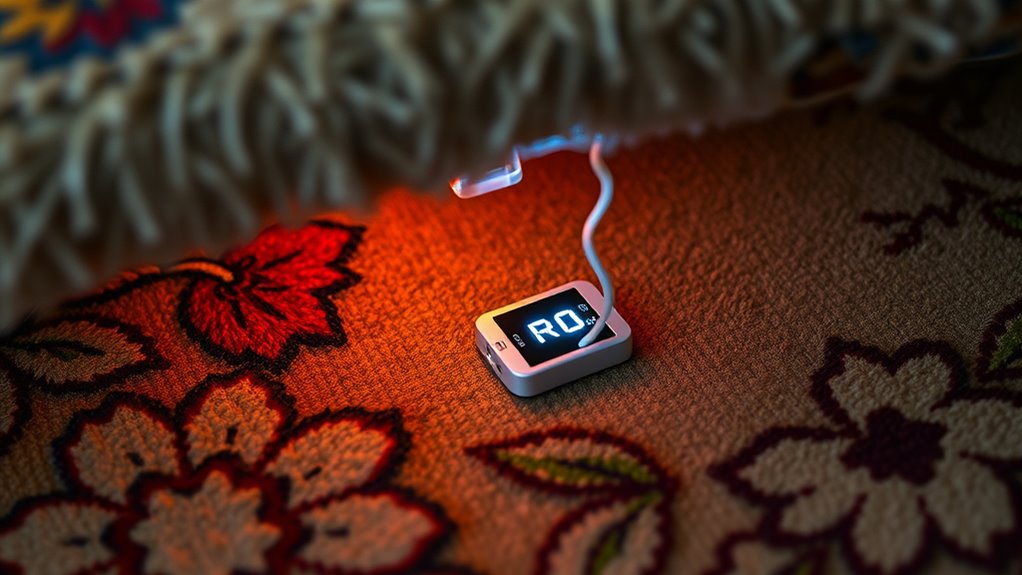
Once your sensors start collecting data, understanding what the readings mean is essential. First, verify your sensors are properly calibrated; inaccurate data can lead to wrong decisions about humidity levels. Regular sensor calibration maintains precision, giving you reliable readings. When interpreting data, look for patterns indicating persistent moisture or sudden changes, which may signal problems like leaks or mold risk. Always keep data privacy in mind—store and share sensor data securely to protect your household’s information. If readings show elevated humidity, take prompt action such as increasing ventilation or using a dehumidifier. Correct interpretation helps you make informed decisions, preventing damage and maintaining a healthy environment. Remember, accurate data and privacy are vital to effective moisture management.
Future Trends and Innovations in Moisture Monitoring Technology

Advancements in moisture monitoring technology are paving the way for more accurate, efficient, and user-friendly solutions. Nanotechnology innovations will enable sensors to detect even microscopic moisture levels, providing real-time insights without false alarms. AI-driven moisture analysis will interpret data instantly, predicting mold growth or structural issues before they escalate. Expect sensors to become smarter, more integrated, and energy-efficient, seamlessly fitting into your environment. Enhanced connectivity will allow remote monitoring, giving you control from anywhere. The table below highlights upcoming trends:
| Future Trend | Impact |
|---|---|
| Nanotechnology innovations | Ultra-sensitive, non-invasive moisture detection |
| AI-driven moisture analysis | Instant, predictive insights for proactive action |
| Smart integration | Seamless data sharing across devices |
| Energy-efficient sensors | Longer battery life, sustainable operation |
These innovations will transform moisture monitoring into a proactive, highly accurate process.
Frequently Asked Questions
How Long Do Smart Sensors Typically Last Before Needing Replacement?
You might wonder how long smart sensors last before needing replacement. Typically, sensor durability depends on quality and usage, but most last around 3 to 5 years. Regularly check for signs of malfunction or inaccurate readings to determine if replacement intervals are needed. Proper maintenance can extend their lifespan. To guarantee continuous monitoring, plan for periodic upgrades or replacements based on the sensor’s performance over time.
Can Smart Sensors Differentiate Between Humidity Sources?
You might wonder if smart sensors can distinguish humidity sources. Notably, they often do, thanks to advanced humidity detection and source identification features. These sensors analyze patterns and specific environmental cues to determine whether humidity comes from spills, leaks, or other factors. While not perfect, many models provide real-time insights, helping you address issues more efficiently and prevent mold or damage from unnoticed moisture.
Are Smart Sensors Safe for Use Around Children and Pets?
You’re wondering if smart sensors are safe around children and pets. Rest assured, most are designed with child safety and pet protection in mind, using non-toxic materials and low-voltage operations. They pose minimal risk when installed properly. Always follow manufacturer guidelines, keep devices out of reach of children and pets, and choose sensors with safety certifications. This way, you guarantee a safe environment while benefiting from real-time humidity monitoring.
What Is the Typical Cost Range for Installing These Sensors?
When considering installation costs, you’ll find sensor pricing varies based on features and brand. Typically, expect to spend between $50 and $200 per sensor. DIY installation can save you money, but professional setup might cost more. Keep in mind that some advanced sensors with extra capabilities could be priced higher. Overall, plan for a range that fits your budget while ensuring reliable monitoring for your humidity needs.
How Do Smart Sensors Connect to Home Automation Systems?
Think of your home automation system as a well-orchestrated symphony, where each device plays its part. Smart sensors connect via wireless connectivity, allowing seamless communication with your system. You simply need to guarantee proper sensor calibration for accurate readings. Once set up, the sensors transmit humidity data wirelessly, enabling your automation system to respond instantly—adjusting humidity levels or alerting you to issues, all effortlessly in harmony.
Conclusion
By embracing smart sensors to monitor humidity under your rugs, you stay ahead of potential damage and mold issues. These devices make moisture management simple and proactive. Remember, a stitch in time saves nine—detecting problems early prevents costly repairs later. Stay vigilant, interpret your sensor data wisely, and take prompt action to keep your home safe and dry. With technology on your side, you can guarantee your living space remains comfortable and protected for years to come.
